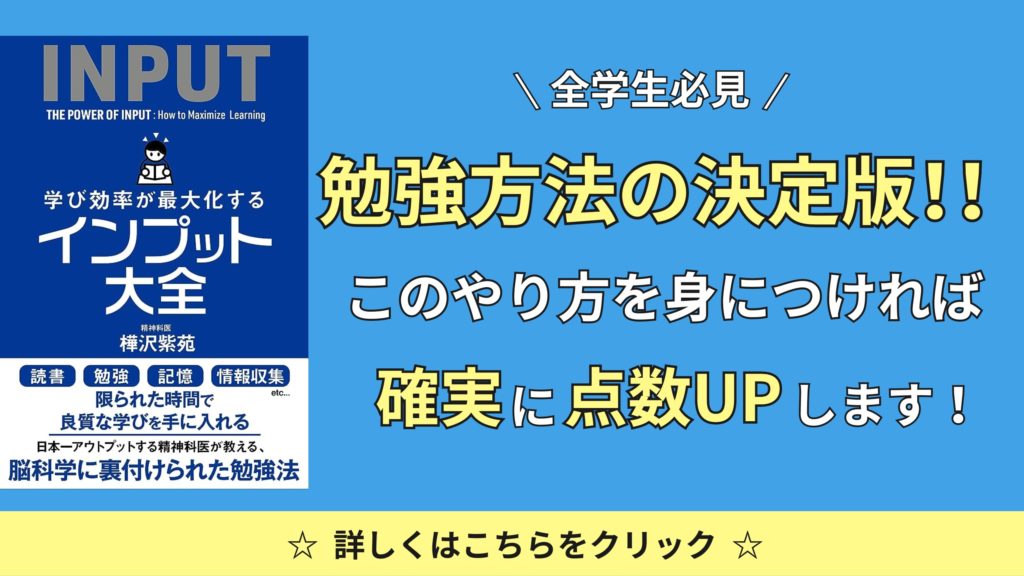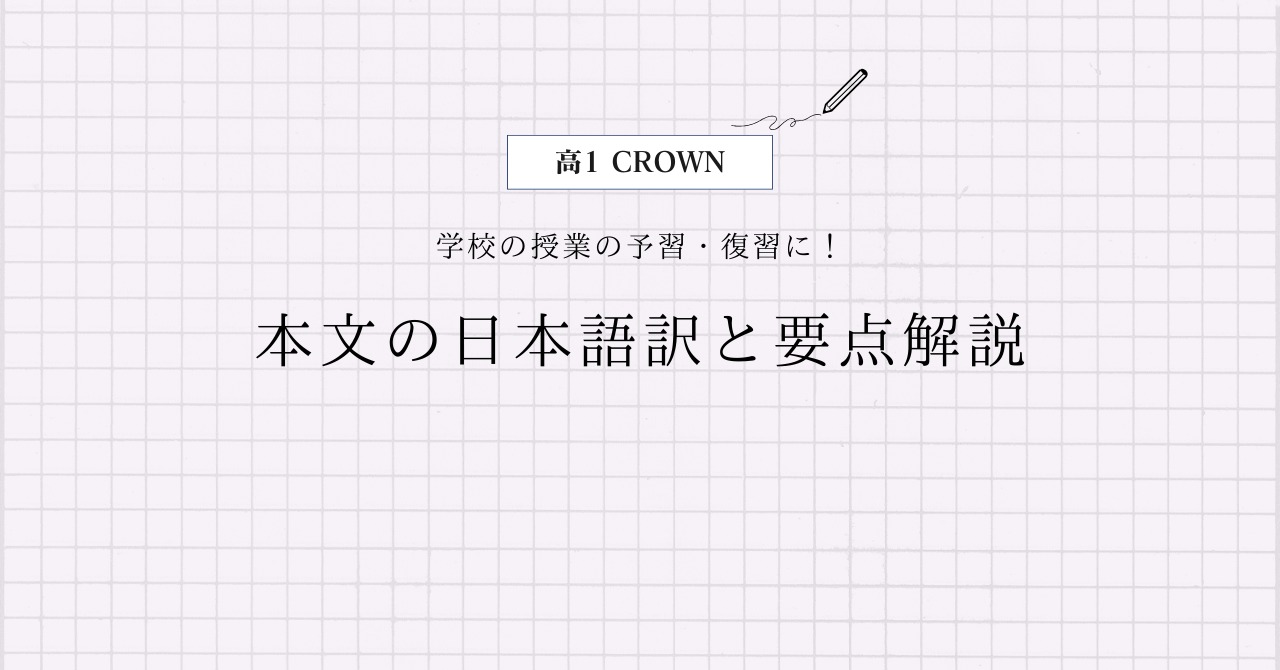三省堂 高1CROWN English Communication1 Lesson4 Section1の本文の日本語訳と重要箇所の解説です。
Section4-2, 4-3, 4-4の解説はこちらからご覧ください。
>高1CROWN English Communication1 Lesson4 Section2 本文和訳
>高1CROWN English Communication1 Lesson4 Section3 本文和訳
>高1CROWN English Communication1 Lesson4 Section4 本文和訳
- CROWN English Communication1 Lesson4 Section1 本文と日本語訳
- CROWN English Communication1 Lesson4 Section1 重要事項の解説
- Digging into Mystery
- They are on a study tour to learn about Australian history and culture.
- They are going to give a presentation about Japanese prehistory.
- 1 Introduction: Dogu and Australian cave paintings
- Yesterday you introduced us to some examples of Australian prehistoric paintings.
- We were very impressed.
- Some of the paintings reminded us of Japan’s prehistoric artifacts.
- The photo on the left is an example of dogu (cf. photo 1).
- They are earthen figures created in the Jomon period (c. 11,000 B.C. – c. 500 B.C.).
- The Australian cave painting on the right is probably older (cf. photo 2).
- There is something strange and mysterious about both these prehistoric artifacts.
- You can’t take your eyes away.
- In a moment, we’ll tell you more about Japan’s mysterious little dogu.
- But first, we’d like to share with you what we’ve learned about life in the Jomon period.
- Incidentally, the Jomon period gets its name from the “rope patterns” that appear in its pottery (cf. photo 3).
- People have found Jomon artifacts all over Japan.
- Misaki, our next speaker, will tell you about what was discovered at one of the most important sites: Sannai-Maruyama.
- CROWN English Communication1 Lesson4 Section1 まとめ
CROWN English Communication1 Lesson4 Section1 本文と日本語訳
Digging into Mystery
「謎を掘り下げる」
Four Japanese high school students from Aomori are visiting their sister school in Sydney, Australia.
「青森出身の4人の高校生がオーストラリアのシドニーにある姉妹校を訪れています。」
They are on a study tour to learn about Australian history and culture.
「彼らはオーストラリアの歴史と文化について学ぶ見学旅行の最中です。」
They are going to give a presentation about Japanese prehistory.
「彼らは日本の先史時代についてのプレゼンテーションを行う予定です。」
Shota will be the first speaker.
「ショウタが最初の話者です。」
1 Introduction: Dogu and Australian cave paintings
「1 導入:土偶とオーストラリアの洞穴壁画」
Good morning. Yesterday you introduced us to some examples of Australian prehistoric paintings.
「おはようございます。昨日はオーストラリアの先史時代の絵の例をいくつか紹介してもらいました。」
We were very impressed.
「僕たちはとても感動しました。」
Some of the paintings reminded us of Japan’s prehistoric artifacts.
「絵のいくつかは僕たちに日本の先史時代の遺物を思い出させます。」
The photo on the left is an example of dogu (cf. photo 1).
「左の写真は土偶の例です。(写真1参照)」
They are earthen figures created in the Jomon period (c. 11,000 B.C. – c. 500 B.C.).
「土偶は縄文時代(紀元前11,000年頃から紀元前500年頃)につくられた土の人形です。」
The Australian cave painting on the right is probably older (cf. photo 2).
「右のオーストラリアの洞穴壁画はおそらくより古いです。(写真2参照)」
There is something strange and mysterious about both these prehistoric artifacts.
「これら先史時代の遺物の両方に,奇妙で不可解なことがあります。」
You can’t take your eyes away.
「あなたたちは目が離せないでしょう。」
In a moment, we’ll tell you more about Japan’s mysterious little dogu.
「すぐに,僕たちが日本の不思議な小さな土偶についてもっと話します。」
But first, we’d like to share with you what we’ve learned about life in the Jomon period.
「でも最初に,僕たちが縄文時代の生活について学んできたことをあなたたちに共有したいと思います。」
Incidentally, the Jomon period gets its name from the “rope patterns” that appear in its pottery (cf. photo 3).
「ちなみに,縄文時代はその時代の陶器に見られる『縄目文様』からその名前が来ています。(写真3参照)」
People have found Jomon artifacts all over Japan.
「人々は日本中で縄文時代の遺物を見つけてきました。」
Misaki, our next speaker, will tell you about what was discovered at one of the most important sites: Sannai-Maruyama.
「次の話者のミサキが,最も重要な遺跡の1つである三内丸山遺跡で発見されたものについて話します。」

CROWN English Communication1 Lesson4 Section1 重要事項の解説
Digging into Mystery
“dig”は「を掘る」という動詞で,ここでは「動名詞」になっていますね。
“dig into~”は「を掘り下げる」という意味で,“mystery“は「謎」という名詞です。
They are on a study tour to learn about Australian history and culture.
“They”は“Four Japanese high school students from Aomori”を指しています。
“be on a trip”で「旅行中だ」という意味で,“study tour”は「見学旅行」です。
“learn”は「を学ぶ,習得する」という動詞で,“to learn”は「不定詞の形容詞的用法」となり,直前の“a study tour”を修飾しています。
“history”は「歴史」,“culture”は「文化」という名詞ですね。
They are going to give a presentation about Japanese prehistory.
“They”は“Four Japanese high school students from Aomori”を指しています。
“give a presentation”で「プレゼンテーションを行う」という表現で,“prehistory”は「先史時代」という名詞になります。
ちなみに先史時代とは,文字で書かれた資料がない時代のことです。
1 Introduction: Dogu and Australian cave paintings
“introduction”は「導入」という名詞です。
“cave”は「洞窟・洞穴」で,“cave painting”は「洞穴壁画」という名詞になります。
洞窟とは比較的大きい空洞のことで,洞穴とは小さい空洞も大きい空洞も両方指します。
Yesterday you introduced us to some examples of Australian prehistoric paintings.
“introduce”は「に紹介する,導入する」という動詞で,“example”は「例」という名詞です。
“of”は前置詞で,”A of B”の形で「BのA」というように後ろから前に訳します。
“prehistoric”は「先史時代の」という形容詞になります。
We were very impressed.
“impress”は「を感動させる」という動詞で,“be impressed”で「感動する,感銘を受ける」という「受動態」の表現になります。
Some of the paintings reminded us of Japan’s prehistoric artifacts.
“remind A of B”で「AにBを思い出させる」という重要表現です。
名詞に‘sを付けると「~の」という所有を表します。
直前の名詞が複数形のときは” teachers‘ “のようにアポストロフィーだけを最後に付けます。
“artifact”は「遺物,人工物」という名詞ですね。
The photo on the left is an example of dogu (cf. photo 1).
“cf.”とはラテン語“confer”の略語で,「~を参照してください」「~と比較してください」という意味があります。
They are earthen figures created in the Jomon period (c. 11,000 B.C. – c. 500 B.C.).
“They”は“dogu”を指しています。
“earthen”は「土の」という形容詞で,“figure”は「形,図,姿」といった名詞です。今回は「人形」としました。
“create”は「を創る」という動詞で,ここでは「過去分詞」として直前の“earthen figures”を修飾しています。
“period”は「時代」という名詞で,西暦の前に付いている“c.”はラテン語”circa”の略語で,「約,~年頃」という意味があります。
“B.C.”は「紀元前」という意味で,“Before Christ(キリストの誕生前)”を略した形です。
ちなみに「紀元後」は“A.D.”=”Anno Domini(主の年)”というラテン語で表されます。もっと詳しく知りたい方は調べてみてください!
The Australian cave painting on the right is probably older (cf. photo 2).
“probably”は「多分,おそらく」という副詞です。
“older”は「比較級」で,“than”はありませんが“dogu”との比較になっていますね。
There is something strange and mysterious about both these prehistoric artifacts.
ここでは「there構文」が使われていますね。
“strange”は「奇妙な,変な」,“mysterious”は「不思議な,不可解な」といった形容詞です。
“something”は「何か」という代名詞で,“-thing”の形の代名詞を形容詞で修飾するときは必ず後ろから修飾します。
“strange and mysterious something”としないように要注意です!
“both”は「両方の」という形容詞,“these”は“this”の複数形で,「これらは(の)」という意味ですね。
You can’t take your eyes away.
“take one’s eyes away”で「目を離す,逸らす」という表現です。
In a moment, we’ll tell you more about Japan’s mysterious little dogu.
“in a moment”は「すぐに」という表現です。
“tell 人 もの”で「人にものを話す,教える」となって,“tell もの to 人”でも同じ意味になります。
他には“teach”, “show”, “give”などが同じ使い方をできるので必ず書き換えられるようにしておきましょう。
“more”は「より多くのこと・もの」という名詞で,“little”は「小さな」という形容詞ですね。
But first, we’d like to share with you what we’ve learned about life in the Jomon period.
“first”は「最初に」といった副詞です。
“would like”は“want”と同じ「~が欲しい」という意味で,“would like to 動詞の原形”は「~したい」となります。
“what”は「関係代名詞」で,“what”1語で”the thing which~(~ということ・もの)”の意味を持ちます。
“(which) we’ve learned about life in the Jomon period”が先行詞“the thing”を修飾しているということですね。また,「現在完了」も使われています。
“share”は「を共有する」という動詞で,“share A with B”で「AをBと共有する」という意味です。
ただ,今回のようにAに入る名詞が長すぎる場合は,Bの後ろに置いてあげます。
Incidentally, the Jomon period gets its name from the “rope patterns” that appear in its pottery (cf. photo 3).
“incidentally”は「ちなみに」という副詞です。
“rope”は「縄」,“pattern”は「文様,模様,見本」,“pottery”は「陶器」という名詞になります。
また,ここでも「主格の関係代名詞that」が使われていて,“that appear in its pottery”が先行詞“the “rope patterns” “を修飾していますね。
“appear”は「現れる,見られる」という動詞です。
People have found Jomon artifacts all over Japan.
ここでは「現在完了」が使われています。
“found”は“find(を見つける)”の過去形・過去分詞形ですね。
“all over”は「~中に」という表現です。
Misaki, our next speaker, will tell you about what was discovered at one of the most important sites: Sannai-Maruyama.
“Misaki”と“our next speaker”は「同格語」になります。“名詞,名詞”の並びは「同格語」の可能性が高いですよ!
ここでも「関係代名詞what」が使われていて,“(which) was discovered at one of the most important sites: Sannai-Maruyama”が先行詞“the thing”を修飾しているということですね。
“discover”は「を発見する,見つける」という動詞で,ここでは「受動態」になっています。
“one of 最上級 複数名詞”は「最も~な名詞の中の1つ」という「比較の応用表現」です。
“site”は「遺跡,場所」といった名詞ですね。
最後の「:」は「コロン」と言い,簡単に言うと「つまり」という具合に直前の文章を補足します。コロンを使うときは,コロンの前は必ず文にしないといけない点に注意してください。

CROWN English Communication1 Lesson4 Section1 まとめ
以上がCROWN English Communication1 Lesson4 Section1の日本語訳となります。
「関係代名詞what」の使い方をしっかり確認しておきましょう!
>高1CROWN English Communication1 Lesson4 Section2 本文和訳
>高1CROWN English Communication1 Lesson4 Section3 本文和訳
>高1CROWN English Communication1 Lesson4 Section4 本文和訳
何か分からない点や他に解説してほしい点があれば,お気軽にコメントしてください!



コメント